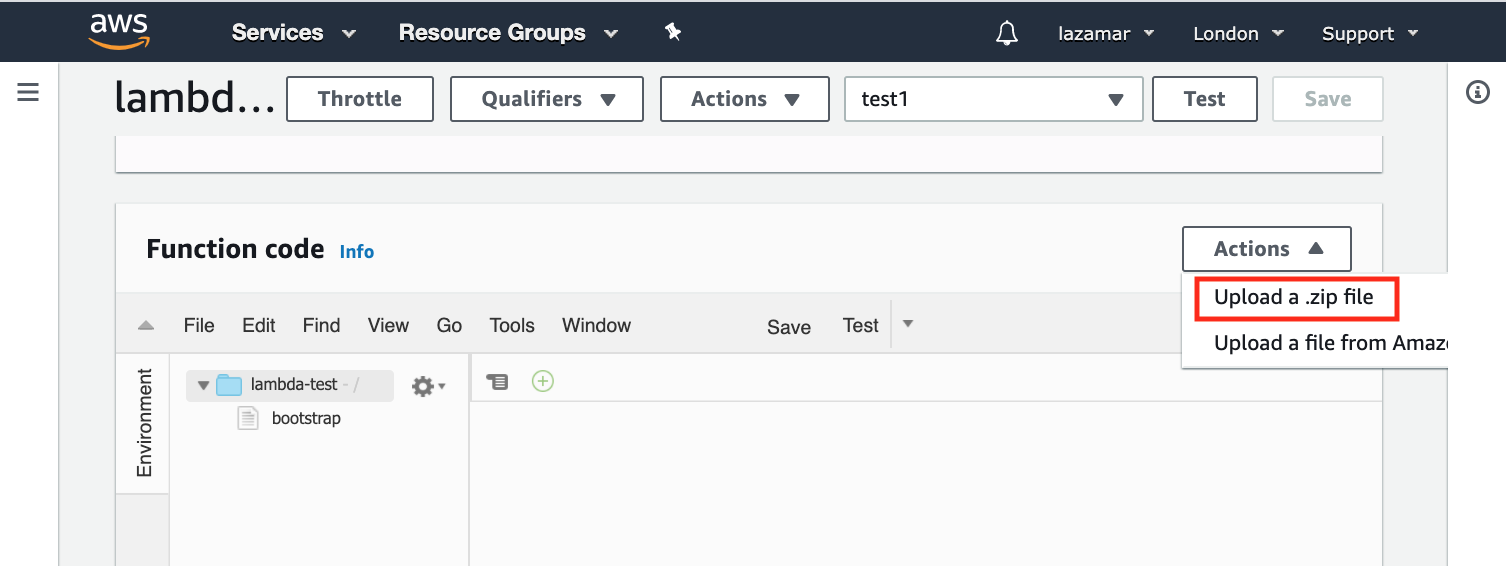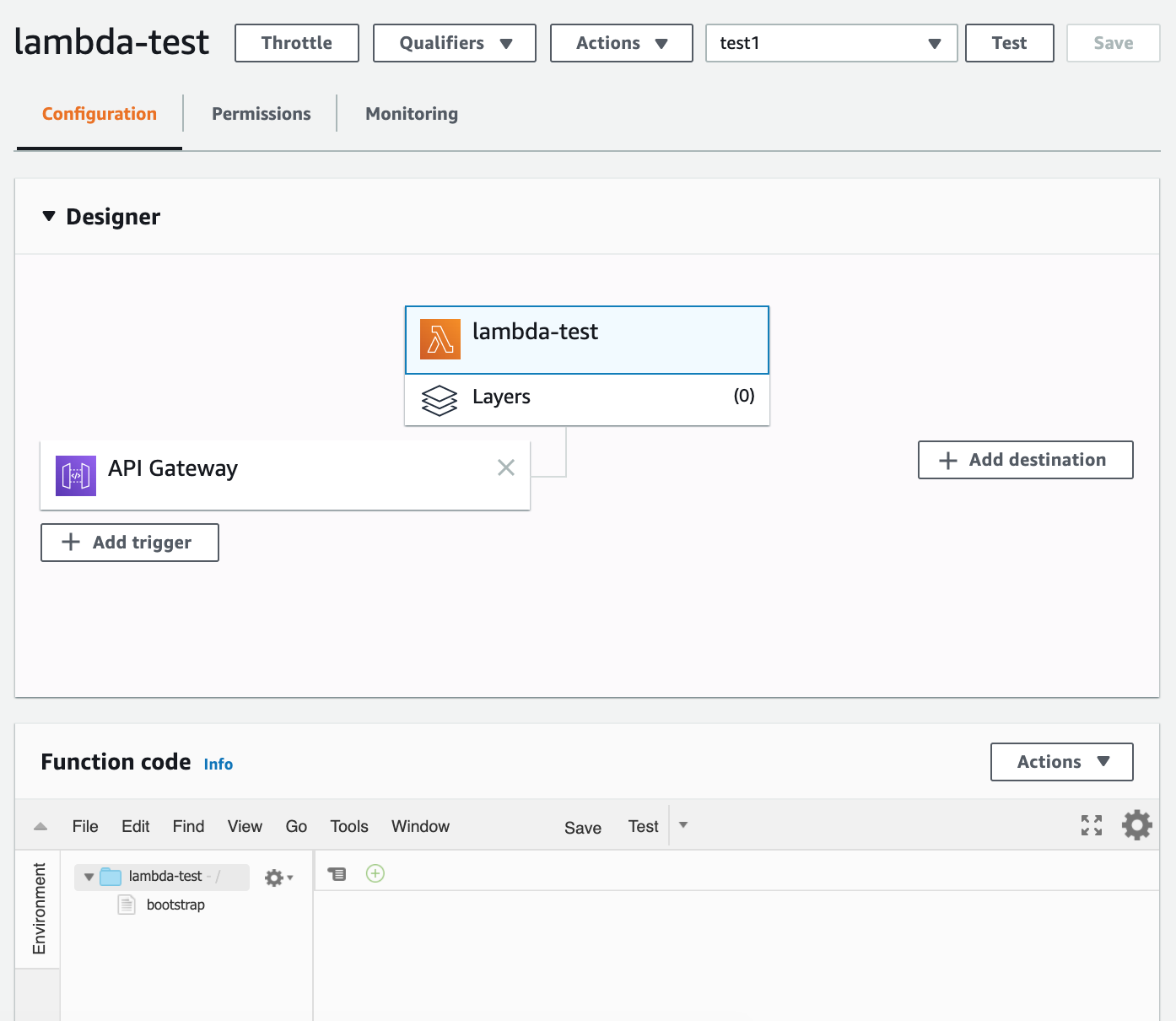In his post about a Telegram bot Joachim Breitner mentions compiling his program into a static binary to have it run in Amazon’s version of Linux without needing to build it inside a container. I was interested in experimenting with Amazon Lambda and having statically linked Haskell programs sounded like a great idea too, so this is a write-up of what it took to get those things working.
In the end we will have a Haskell program compiling to a statically linked binary, being built quickly by making use of Nix and Cachix and automatically deployed to Amazon Lambda using GitHub Actions.
The code for this post can be found at lazamar/lambda-haskell.
In Lambda we need a special wrapping layer to run Haskell code. I’m using
aws-lambda-haskell-runtime
for that. I wanted to see what data from the request Amazon was making available, so the
program will simply get a request as a JSON, prettify it and return that. This is Main.hs,
the only Haskell file.
{-# LANGUAGE DeriveGeneric #-}
{-# LANGUAGE DeriveAnyClass #-}
{-# LANGUAGE DuplicateRecordFields #-}
{-# LANGUAGE NamedFieldPuns #-}
{-# LANGUAGE OverloadedStrings #-}
module Main where
import Aws.Lambda
import Aws.Lambda.Runtime
import GHC.Generics
import Data.Aeson
import Data.Aeson.Encode.Pretty
import Data.Either
import Data.Text (Text)
import Data.Text.Lazy (toStrict)
import Data.Text.Lazy.Encoding (decodeUtf8)
import Network.HTTP.Types.Header
main :: IO ()
main = runLambda run
where
run :: LambdaOptions -> IO (Either a LambdaResult)
run opts = do
result <- either (error . show) id $ handler <$> (decodeObj (eventObject opts)) <*> (decodeObj (contextObject opts))
either error (pure . Right . StandaloneLambdaResult . encodeObj) result
type Request = Value
data Response = Response
{ statusCode :: Int
, headers :: [(Text, Text)]
, body :: Text
, isBase64Encoded :: Bool
} deriving (Generic, ToJSON)
handler :: Request -> Context -> IO (Either String Response)
handler e context = return
$ Right
$ Response 200 mempty (toStrict $ decodeUtf8 $ encodePretty e) False
We can build that with Cabal and a small lambda-test.cabal file.
cabal-version: >=1.10
name: lambda-test
version: 0.1.0.0
author: Marcelo Lazaroni
build-type: Simple
executable lambda-test
main-is: Main.hs
build-depends:
base
, aeson
, aeson-pretty
, text
, aws-lambda-haskell-runtime >= 2.0.1 && < 3.0.0
, http-types
default-language: Haskell2010
To statically link our Haskell program I used Nix and made use of the excellent static-haskell-nix project.
They created a nix file that modifies all existing Haskell packages in Nix to have them and all of their dependencies be statically linked.
They also keep a list of packages that do not successfully compile with this approach. It works with more than 90% of Stackage.
Here is my deafult.nix.
# Little snippet from Niv to get our pinned dependencies
{ sources ? import ./nix/sources.nix }:
with { overlay = _: pkgs: { niv = import sources.niv {}; }; };
let
# We use a nixpkgs version with modified configuration to build static
# executables. From https://github.com/nh2/static-haskell-nix
pkgs = (import (sources.static-haskell-nix + "/survey/default.nix") {
# This is the nixpkgs revision we are modifying.
# We pinned the revision with 'niv add NixOS/nixpkgs -a rev=<sha256>
normalPkgs = import sources.nixpkgs {};
}).pkgs;
# Nix usually takes all files in the source directory into consideration and
# busts the cache whenever any of these files change. To avoid that
# we use hercules-ci/gitignore.nix so that nix will ignore files included in
# our .gitignore
gitignoreSource = (import sources.gitignore { lib = pkgs.lib; }).gitignoreSource;
lambda-test =
pkgs.haskell.lib.overrideCabal
# Create a nix derivation from the cabal package
(pkgs.haskellPackages.callCabal2nix "lambda-test" (gitignoreSource ./.) {})
# Set flags that make sure that we are building a truly static executable
(old: {
configureFlags = [
"-flambda"
"--ghc-option=-optl=-static"
"--extra-lib-dirs=${pkgs.gmp6.override { withStatic = true; }}/lib"
"--extra-lib-dirs=${pkgs.zlib.static}/lib"
"--extra-lib-dirs=${pkgs.libffi.overrideAttrs (old: { dontDisableStatic = true; })}/lib"
"--disable-executable-stripping"
];
});
# Create a zip file ready to be sent to AWS lambda
function-zip = pkgs.runCommandNoCC "lambda-test.zip" { buildInputs = [ pkgs.zip ]; }
''
mkdir -p $out
cp ${lambda-test}/bin/lambda-test bootstrap
zip $out/function.zip bootstrap
'';
in
{ inherit
lambda-test
function-zip ;
}
I used Niv to pin the Nix derivations I was using to precise
commits. This is great to make sure that my build will be exactly the same even if I’m on a machine
with a different revision of nixpkgs or if the derivations I use are updated.
Adding a package with Niv is super simple. Just niv add nh2/static-haskell-nix will pin a
version of static-haskell-nix in a json file under the newly created nix directory and by
adding two lines of code at the beginning of my Nix file to load the Niv sources I can use it
with sources.static-haskell-nix.
To have all of the modified Nix packages I import sources.static-haskell-nix + "/survey/default.nix".
After doing that I found that the project is pinned to an old revision of nixpkgs and I needed
a more recent one for callCabal2nix (it goes into an infinite loop in the pinned one).
To override it I pinned my desired revision with niv add NixOS/nixpkgs -a rev=<sha256> and
used it by setting the normalPkgs attribute with this line:
normalPkgs = import sources.nixpkgs {};
I use cabal2nix to transform my Cabal file into a
Nix derivation.
callCabal2nix is a convenience function that allows us to use cabal2nix without needing two
nix files (the converted-to-nix cabal and the actual build instructions). I can just have the
nix file with build instructions converting our cabal file to nix on the fly.
callCabal2nix gets the sources it will use as input. Usually I would just pass the entire
directory to it. However, whenever I run nix-build the result gets compiled to the result
subdirectory which means that there was a change to our sources and things will be rebuilt the
next time I run nix-build again. That’s not very smart. It is not true that everything in the
repository is source code. Actually only things tracked by git are real source code and it
would be smarter if only those files were taken into consideration. And that’s exactly what
hercules-ci/gitignore.nix does.
Finally I use the overrideCabal function to make sure GHC will use statically-linked everything.
With all of that in place I can run nix-build --attr lambda-test default.nix and after a few
hours of downloads and compilation I have a binary under result/bin/lambda-test.
I can confirm that this is not using any dynamically linked libraries like so:
>> ldd result/bin/lambda-test
ldd: result/bin/lambda-test: Not a valid dynamic program
Success!
For this to work in Lambda I need to rename it to bootstrap and provide it wrapped in a zip
file named function.zip. I copied Joachim Breitner’s Nix snipped to automate that in function-zip.
Now I can run nix-build and inside the result folder there will be a function.zip. This is
the file I will upload to Lambda further down.
Caching
Building it once took very long. Thankfully Nix reuses that and it will be rather quick to rebuild this code in the same machine. Nonetheless, whenever I want to build it somewhere else the process will start again.
To avoid that I use Cachix, a content-addressed binary cache that will allow me to share the compilation work I do locally with other machines.
To set it up I installed Cachix (nix-env -iA cachix -f https://cachix.org/api/v1/install),
created an account at https://cachix.org/ and clicked the Create binary cache button there,
which allowed me to create my lazamar cache.
I wanted to use my cache as well as the static-haskell-nix cache.
cachix use static-haskell-nix
cachix use lazamar
Now I just needed to make sure to upload my results whenever I built the project.
nix-build | cachix push lazamar
Voilà. Now I don’t have to go through hours of compilation when moving machines. And most importantly neither does CI.
Amazon Lambda
Amazon Lambda allows you to deploy a server that is off most of the time and wakes up only when a request arrives. This is great because you don’t need to pay to keep it running all the time, you only pay for the small bursts of activity.
There are ways to use it with various languages, but for Haskell I can use aws-lambda-haskell-runtime
and just provide a binary inside a zip. Pretty simple.
For instructions on how to create a Haskell Lambda you can follow this guide.
When I created a Lambda in Amazon I found out that it can’t automatically talk to the world. To do that I needed to add an API layer to the set-up. That would allow me to talk over HTTP.
I added an API Gateway layer and configured it as a proxy.
That gave me a URL to query my service. After uploading the zip I could see the prettified JSON
response as expected.
This is where the upload zip button is hidden:

And here is how the set-up looks like:

Continuous Delivery
The last step remaining is having the code automatically built and deployed to Lambda every time I push a commit to GitHub.
GitHub Actions are very very easy to set-up and understand as well as being extremely convenient. Still, I found the documentation to be overly verbose. If you are not familiar with GitHub Actions, I found the Workflow Configuration and the Workflow Syntax pages to have the most useful info to get started.
I created a workflow and enabled GitHub Actions by adding .github/workflows/ci.yaml to the repo.
And that file looks like this:
name: CI
# Trigger the workflow on push or pull request, but only for the master branch
on:
pull_request:
push:
branches: [master]
jobs:
main:
name: Build
runs-on: ubuntu-latest
steps:
# Load the source code into CI by checking out the branch
- uses: actions/checkout@v2
# Install cachix
- uses: cachix/install-nix-action@v10
# Sign-in to cachix. This allows me to save to cachix
# the binaries created during CI runs
- uses: cachix/cachix-action@v6
with:
name: lazamar
signingKey: '${{ secrets.CACHIX_SIGNING_KEY }}'
# Select the caches I want to use
- run: cachix use lazamar
- run: cachix use static-haskell-nix
# Build my code and save binaries to my cache if they are not already there
- run: nix-build | cachix push lazamar
- name: AWS setup
uses: aws-actions/configure-aws-credentials@v1
with:
aws-access-key-id: ${{ secrets.AWS_ACCESS_KEY_ID }}
aws-secret-access-key: ${{ secrets.AWS_ACCESS_KEY_SECRET }}
aws-region: eu-west-2
- name: Deploy to Lambda
run: |
aws lambda update-function-code --function-name lambda-test --zip-file fileb://result/function.zip
This is a workflow that will be triggered for pull requests and pushes to master and contains
8 steps.
Those secret variables you see are set in https://github.com/<user>/<project>/settings/secrets.
You can read more about handling them here.
You can also go here to learn how to create a Cachix signing key, and here to learn about creating Amazon access key ID and secret access key.
For more elaborate Haskell building I recommend Dmitrii Kovanikov’s Dead simple cross-platform GitHub Actions for Haskell.
This concludes the full set-up. With that I have code quickly compiled to a statically-linked binary in CI and automatically deployed to Amazon Lambda on every push.